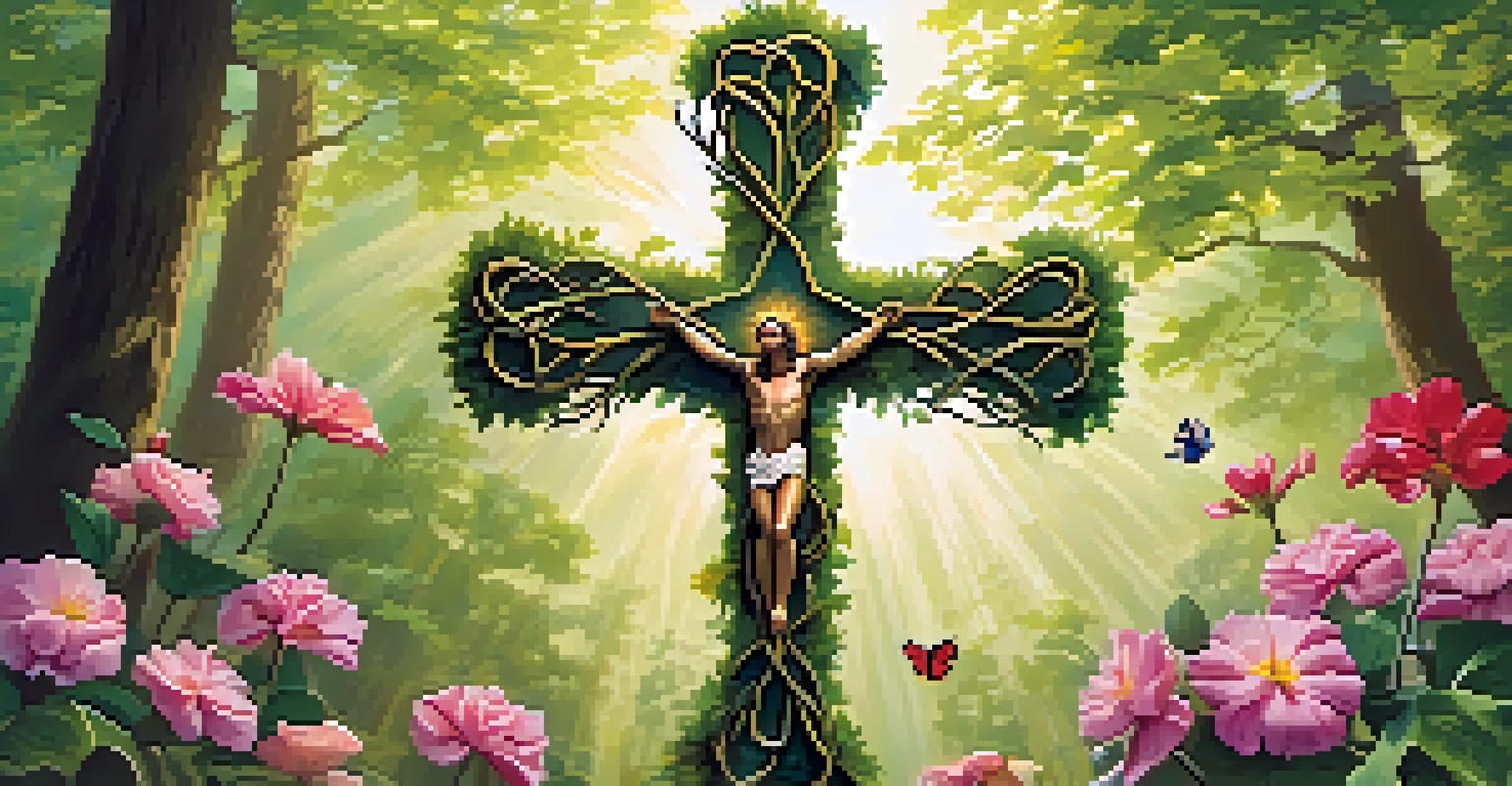The Cross: A Deep Dive into Its Spiritual Symbolism

Understanding the Cross: A Universal Symbol
The cross is more than just a religious emblem; it’s a universal symbol that transcends cultures and beliefs. It often represents the intersection of the divine and the earthly, suggesting a bridge between heaven and humanity. Many cultures have adopted the cross, each adding its layers of meaning, which enriches its significance. For example, in ancient civilizations, the cross was seen as a symbol of life and death, embodying the cyclical nature of existence.
The cross is a symbol of God's love for us, but it is also a reminder of the love we are called to share with others.
In Christianity, the cross is particularly significant as it symbolizes the sacrifice of Jesus Christ. This act of love and redemption is central to Christian belief, making the cross a powerful reminder of hope and forgiveness. It serves as a visual representation of the promise of eternal life, encouraging believers to reflect on their faith and relationship with God. Thus, the cross becomes not just a symbol but a profound statement about human existence and divine love.
Moreover, the cross has inspired countless works of art, literature, and music, each exploring its themes of sacrifice, redemption, and hope. This artistic representation makes the cross relatable, allowing individuals to connect with its meaning on a personal level. Whether seen in a church, a piece of jewelry, or on a hillside, the cross continues to evoke deep emotional responses, reminding us of its enduring power across generations.
The Cross in Various Religious Contexts
While the cross is predominantly associated with Christianity, its symbolism appears in various other religions as well. For instance, in ancient Egyptian culture, the ankh, resembling a cross, symbolizes life and immortality. Similarly, in Celtic traditions, the cross often features a circle, representing the eternal cycle of life and the interconnectedness of all things. These examples illustrate how the cross transcends religious boundaries, embodying universal themes of life, death, and continuity.

In Buddhism, while not a direct symbol, the cross shape emerges in mandalas and other spiritual artwork, symbolizing balance and harmony. The crossing lines can represent the union of opposites, such as male and female energies or the spiritual and material worlds. This interpretation broadens our understanding of the cross, showing how its essence resonates across different belief systems, emphasizing unity and balance in the human experience.
The Cross as a Symbol of Hope
The cross embodies themes of sacrifice and redemption, offering hope and connection to individuals across various cultures and beliefs.
The diverse interpretations of the cross in various faiths highlight humanity's shared quest for meaning and understanding. Each culture adapts the symbol to express its unique spiritual journey, yet the underlying themes remain remarkably consistent. This shared symbolism invites us to explore our beliefs and acknowledge the common threads that connect us, reinforcing the notion that, despite our differences, we all seek understanding and connection.
Historical Perspectives on the Cross
The history of the cross is rich and complex, dating back thousands of years. Initially seen as a method of execution in Roman times, the cross became a potent symbol of shame and suffering. However, with the crucifixion of Jesus, this perception shifted dramatically. The cross transformed from an instrument of death into a symbol of hope and salvation, illustrating the profound impact of historical events on spiritual symbols.
In the shadow of the cross, we find the true meaning of sacrifice and the hope of redemption.
Throughout history, the cross has been used to signify both oppression and liberation. During the Crusades, for example, it became a banner for both conquest and faith. This duality reflects the broader human experience, where symbols can be interpreted in various ways, depending on context and perspective. Thus, the cross stands as a testament to the complexities of faith, power, and human intent through the ages.
As centuries passed, the cross evolved, appearing in art, architecture, and everyday life. Its representation in churches and public spaces conveys its significance as a spiritual anchor for many. This evolution illustrates how symbols adapt and change, reflecting societal values and beliefs over time. The cross, therefore, not only tells a story of spiritual meaning but also encapsulates the historical journey of humanity itself.
The Cross as a Symbol of Sacrifice
At its core, the cross epitomizes sacrifice, a theme that resonates deeply within the human experience. In Christianity, it symbolizes Jesus’ ultimate sacrifice for humanity’s sins, embodying selflessness and unconditional love. This notion of sacrifice encourages individuals to reflect on their own lives and consider how they can contribute positively to the world around them. The cross thus serves as a reminder that love often requires sacrifice, urging us to embrace this value in our interactions with others.
The idea of sacrifice extends beyond the religious context, touching on everyday acts of kindness and generosity. Many people find inspiration in the cross to engage in altruistic behaviors, whether through charitable works or personal sacrifices for loved ones. This connection between the cross and everyday life highlights its capacity to inspire positive actions, fostering a sense of community and belonging. Ultimately, the cross becomes a call to action, encouraging us to embody the virtues it represents.
Cultural and Religious Significance
While primarily associated with Christianity, the cross also appears in other religions, symbolizing universal themes of life, death, and continuity.
In a world often marked by self-interest, the symbolism of the cross can remind us of the importance of putting others first. By making sacrifices for those we care about, we not only honor the spirit of the cross but also create a ripple effect of kindness. This transformative power of the cross illustrates its relevance today, urging us to live out its teachings and embrace a life of love, service, and connection.
The Cross and Redemption Themes
Redemption is a central theme associated with the cross, offering hope to those who feel lost or burdened. In Christianity, the crucifixion represents the ultimate act of redemption, where Jesus’ death signifies the forgiveness of sins and the promise of eternal life. This powerful narrative resonates with many individuals who seek healing and restoration in their own lives. The cross thus becomes a beacon of hope, reminding us that redemption is always possible, regardless of our past.
The concept of redemption extends beyond religious boundaries, as people from various walks of life grapple with their own challenges and seek transformation. Many find solace in the cross as a symbol of second chances and new beginnings. This universality allows the themes of the cross to reach a broader audience, encouraging individuals to pursue personal growth and healing. The message of redemption inherently fosters resilience, urging us to persevere through difficulties.
By embracing the cross as a symbol of redemption, we can cultivate a mindset of forgiveness and acceptance, both for ourselves and others. This perspective encourages us to let go of guilt and shame, allowing us to move forward with renewed purpose. In this way, the cross becomes not just a symbol of suffering, but a powerful reminder of the potential for transformation and renewal that exists within each of us.
The Cross in Art and Culture
The cross has inspired countless artists throughout history, serving as a powerful symbol in visual art, literature, and music. From Renaissance paintings depicting the crucifixion to contemporary sculptures, artists have explored the deep emotional and spiritual implications of the cross. This rich artistic tradition encourages viewers to engage with the symbol on a personal level, prompting reflection on their beliefs and values. The cross thus transcends its physical form, becoming a conduit for deeper understanding and exploration.
In literature, the cross often serves as a central motif, symbolizing conflict, redemption, and the human condition. Writers utilize the cross to explore themes of sacrifice, love, and the search for meaning, inviting readers to consider their own journeys. Through storytelling, the cross becomes a powerful narrative device that resonates with the human experience, encouraging us to engage with complex emotions and ideas. This literary representation enriches our understanding of the cross and its significance across cultures.
Artistic Inspiration and Reflection
The cross has inspired countless works of art, literature, and music, encouraging personal reflection and deeper understanding of its significance.
Music also plays a vital role in expressing the symbolism of the cross, with hymns and contemporary songs reflecting its themes of love and sacrifice. These musical interpretations allow individuals to connect with the cross in a unique way, often evoking deep emotional responses. Whether in a worship setting or a personal moment of reflection, music brings the symbolism of the cross to life, creating a shared experience that resonates within communities. Ultimately, the cross continues to inspire creativity and dialogue, reinforcing its importance in art and culture.
Personal Reflections on the Cross
Engaging with the cross on a personal level invites us to explore our beliefs and experiences. For many, the cross represents a source of comfort during difficult times, offering a sense of connection to a higher power. This personal relationship with the cross can foster a deeper understanding of one's faith, encouraging individuals to seek solace in moments of despair. Reflecting on the cross allows us to confront our struggles and reaffirm our resilience, reminding us that we are not alone in our journeys.
Moreover, the cross can serve as a powerful symbol of identity for individuals within various faith communities. It can embody shared beliefs, traditions, and values, creating a sense of belonging among members. This communal aspect of the cross highlights its role in fostering connections with others who share similar spiritual journeys. By embracing the cross as part of our identity, we can find strength in unity and shared purpose.

Ultimately, personal reflections on the cross encourage us to consider how its symbolism resonates in our lives. Whether through prayer, meditation, or artistic expression, engaging with the cross can lead to profound insights and understanding. By exploring our relationship with this powerful symbol, we can deepen our spiritual journeys and find new ways to navigate the complexities of life with grace and hope.